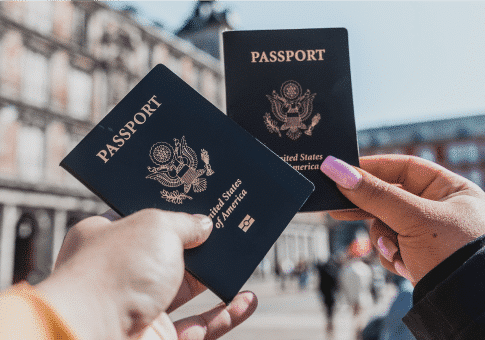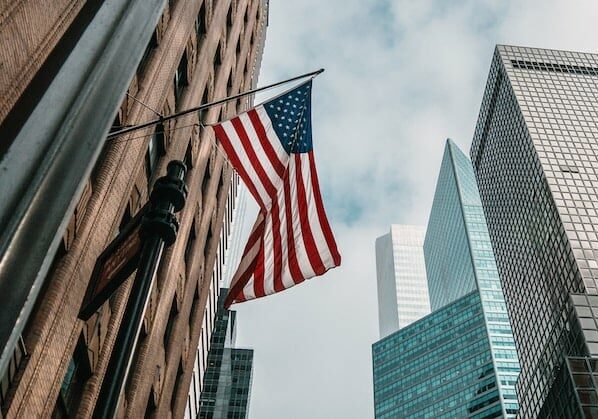What is the L-1 Visa?
Are you interested in moving to the US with your current foreign company? You’re in the right place. This comprehensive guide on the L-1 visa from GCS is a valuable tool for international companies seeking to transfer key employees to their U.S. operations.
Designed for executives, managers, and specialized knowledge professionals, the L-1 visa facilitates seamless intra-company transfers and supports multinational companies.
In this ultimate guide to the USA L-1 Visa you will learn about:
- What the USA L-1 Visa is
- The visa requirements
- The application process for the L-1 visa
- How much an L-1 visa costs, processing times, and more
What is the L-1 Visa?
The L-1 Visa is a non-immigrant visa that is the ideal option for foreign nationals who want to live and work in the US with the same company they are already working for in their home country.
This inter-company transfer visa offers foreign nationals the chance to remain in their current position while immigrating to the US.
L-1 Visa Categories
L-1A Visa
The L-1A Visa, also known as the L-1A Intracompany Transferee Executive or Manager Visa, streamlines the relocation of foreign executives and managers to their company’s US offices. It can also be used by a foreign company without existing US branches to transfer an executive or manager to establish one.
The United States Citizenship and Immigration Services USCIS imposes strict conditions that L-1 Visa applicants must meet to be considered for approval. Merely holding the title of “Manager” and supervising lower-level employees does not automatically qualify an applicant for the L-1A visa.
L-1A Visa definition of an executive or manager

- Oversees the day-to-day management
- Establishes company policies and goals
- Holds discretionary authority for executive decisions
- Supervises high-level employees with minimal supervision from higher-level directors and stockholders.
A manager is an individual who heads a key department, supervises higher-level workers, possesses hiring and firing authority, and directs daily company operations.
L-1B Visa
The L-1B Visa, known as the L-1B Intracompany Transferee Specialized Knowledge Visa, facilitates the transfer of foreign workers who possess specialized knowledge to the US. These specialized knowledge employees are crucial to various company functions related to its interests, with no specific guidelines outlining these functions. The USCIS relies on its officers’ discretion to determine eligibility.
Like the L-1A visa, the L-1B visa allows the relocation of foreign workers to open new branches, subsidiaries, or affiliates in the US. Obtaining an L-1B visa generally requires possessing “specialized knowledge” per the USCIS definition, which can be subjective and challenging for companies to navigate.
L-1B Visa basic requirements
Specialized knowledge, as defined by the USCIS for L-1B visa purposes, refers to an employee’s extensive understanding of the company’s products, services, techniques, equipment, research, or management processes and how they apply internationally.
This definition can be ambiguous, and meeting it involves more than just years of specialist experience. The knowledge must be unique enough to distinguish the employee from others in the same field, and in some cases, the visa applicant must belong to specific profession.
To qualify for the L-1B visa, the foreign company must demonstrate to the USCIS that the applicant’s specialized knowledge is not commonly held in the international market and is essential for addressing key issues related to their US business interests. Evidence should include the time taken to acquire this specialized knowledge, its value to the US company, and its uniqueness. Ultimately, the employee’s skill or knowledge must be indispensable to the organization’s operations.
L-1 Visa Requirements
Both the employer and employee of the foreign company must fulfill a set of requirements for the L-1 visa petition to be filed successfully.
Employer requirements
For an L-1 Visa, the US-based employer and its foreign company where the employee works must have a qualifying relationship. Additionally, while the employee is in the US, the employer needs to be doing business both in the US and in at least one other country. These requirements make the L-1 Visa more appropriate for large multinational companies rather than small ones.
Relationship between the employer and the employee
The main requirement for employers seeking the L-1 visa for an employee is providing evidence of the relationship between the two. This often means demonstrating the relationship between the US company and the foreign company. Here are the main company relationship types:
- Parent or subsidiary: A parent company is a legal entity that owns and controls another entity, known as a subsidiary. Ownership typically involves holding at least 50 percent of an organization, which the USCIS considers sufficient to show the company’s control over its management and operations.
- Affiliate: Affiliate relationships are where various entities are controlled and owned by the same parent company.
- Branch: A branch refers to a location where the same operations of the company occur but merely in a separate location.
Employee requirements
The foreign national must be employed by the foreign company for at least one year within the previous three years, in a specialized knowledge, managerial or executive position. Generally, the employee must be overseeing a large portion of the company’s functions and operations.
Note, there is an exception to this rule. Namely, US locations that have been running for less than a year can qualify under a separate provision (L-1 New Office). With this, the visa applicant can work for the US company that filed the application.
L-1 Blanket Petitions

To qualify for an L-1 Blanket Petition, the company must:
- Have at least three branches, subsidiaries, or affiliates, whether in the US or abroad
- Have an office that has been doing business in the US for at least one year
- Have filed at least ten successful L-1 petitions in the preceding twelve months
- Have at least 1,000 employees based in the US
- Be able to show that the US affiliates or subsidiaries have annual sales of at least $25 million
L-1 Visa Application Process
The L-1 application process has requirements for both the employer and employee. Generally, it is as follows:
- Gather supporting documents: Before an employer sends in an application it is vital to ensure you have the correct supporting documents including an offer of employment, evidence of the relationship, ownership, control etc.
- File Form I-129: This must be filled out by the employer at least 45 days before the employee’s start date, and no more than six months before employment begins.
- Receive Notice of Approval: If approved USCIS will provide Form I-797 (Notice of Approval).
- Consular Processing: The foreign employee must fill in Form DS-160, pay the visa fee, provide biometric information, and attend a visa interview at a US consulate or embassy in their home country.
If all is in order, the foreign employee will receive an L-1 visa stamp in their passport and can enter the US.
Extending the L-1 visa
If you are already in the US on an L-1 visa you can request to extend your visa, here is what is required:
- Proof of the beneficiary’s employment for the duration of their time in the US
- Evidence of the beneficiary’s US work-relevant degree (or foreign equivalent)
- Letter for a foreign employer detailing the beneficiary’s previous three years of employment
- Support letter from petitioner, including alien’s salary, job duties, terms of employment, etc.
- Summary and proof of travel history outside of the US (boarding passes, passport stamps, etc.)
- Completed I-129 Petition
L-1 Visa Processing Time
The timeframe for processing the I-129 petition typically varies depending on the USCIS service center where it was submitted and the applicant’s home country. On average, it takes about six months for the I-129 petition to be processed. For consular processing, the wait time can also extend to six months or more, especially if there are Requests for Evidence (RFEs) involved.
Premium Processing offers a quicker alternative. Under this system, USCIS commits to processing the application within 15 calendar days, a significant improvement from the usual six-month wait.
However, this expedited service comes with an additional fee of approximately $2,805 and does not guarantee visa issuance. There may also be additional fees based on your specific case. If USCIS fails to process the application within 15 days, they will provide a full refund.
Benefits of the USA L-1 Visa
There are several benefits for the L-1 visa, including:
- Family benefits: Spouses and children under the age of 21 of the L-1 visa holder can enter the US. Spouses can also apply for work authorization.
- Dual intent visa: An L-1 is a dual intent visa, meaning a visa holder can apply for a Green Card without jeopardizing their visa status.
- No employment caps: One of the main benefits of the L-1 visa is that there are no annual caps, allowing companies to apply for as many L-1 visas as necessary.
- No wage requirements: Unlike many other employment visas, the L-1 does not have a minimum wage requirement.
- Flexible duration: The L-1A is initially granted for up to three years with an extension available for up to seven years. The L-1B is also granted for three years initially with extension options for up to five years.
L-1 Visa Limitations
While the L-1 visa has many benefits, there are also some limitations to this visa category, for example:
- An employee must already be employed, and they need to be in a managerial or executive position or be a specialized knowledge worker, and they must have held that position for at least one year.
- The company that employs an L-1 visa holder must also meet certain eligibility requirements: They must be a multinational company that has a branch, affiliate, subsidiary or parent in the US.
How long is the USA L-1 Visa valid for?
L-1A visas have a three-year validity, and can be extended in two-year periods up to seven years (maximum). Meanwhile, L-1B visas can be approved for a maximum of three years, and then can be extended for two extra years (Up to five years validity).
If you opt to go for the ‘new office’ L-1 visa route, then note that visas are only approved for a one-year period.
The duration of validity of the L-1 Visa varies largely based on the relations of the country of origin of the worker with the United States. For countries such as India and Japan, the L-1 Visa is granted for five years, which can be extended for two years. If you’re applying for the L-1 Visa, please check the US government website to refer to the reciprocity schedule and check the status of your country. There are also certain exemptions granted to specific countries relating to documents and paperwork.
How much does an L-Visa cost?
- Form I-129 (Petition for Nonimmigrant Worker) filing fee: $1,385
- Anti-fraud fee (if applicable):$500
- Premium processing (optional): $2,805
The Consolidated Appropriations Act signed into law an additional fee for certain companies that fit specific criteria. The additional fee of $4,500 is applicable to L-1 petitioners if:
- They are required to submit the Fraud Prevention and Detection fee;
- They employ 50 or more individuals in the US; and
- More than 50 percent of those employees are in H-1B, L-1A, or L-1B nonimmigrant status.
There are various additional fees based on your specific case that may be applicable. It’s best to navigate the cost with the official fee schedule.
What other visas are similar to the USA L-1 Visa?

A pathway to attaining lawful permanent resident status is possible, provided that the investment is kept for a set number of years. Note that while the E2 visa has a nonimmigrant status, it doesn’t directly lead to a green card, the EB5 visa scheme does offer a legitimate pathway to a green card and permanent residency.
For business-related visits to the US, such as business meetings, conferences, and negotiating contracts, you may want to consider the B-1 US Visa.
Why work with Global Citizen Solutions?
Global Citizen Solutions is a boutique investment migration consultancy firm focused on finding the right residency or citizenship by investment program for individuals wishing to secure their future and become global citizens. With offices in Portugal, the United Kingdom, Hong Kong, and Brazil, our multilingual team guides individuals and families from start to finish, providing expert advice considering freedom, mobility, taxation, and security.
- We have helped hundreds of clients from 35+ countries in all the top Residency by Investment and Citizenship by Investment programs. With an in-depth and comprehensive understanding of the area, we provide our clients with solid guidance. We have a team of immigration lawyers, and immigration advisers specialized in US immigration.
- Our team has never had a case rejected. Our 100 percent approval rate sets us apart from our competitors and guarantees that you can expect a successful application.
- Our transparent pricing covers all the processes from opening your bank account, document certification, and legal due diligence to investment and submission. As there is one fee for the entire process, you can be confident that you will not face any hidden costs later.
- All data is stored within a GDPR-compliant database on a secure SSL-encrypted server. You can be safe knowing that your personal data is treated with the utmost security.
- Global Citizen Solutions provides an all-encompassing solution. Our support can continue even after you receive your passport. We offer additional services such as company incorporation, Trusts, and Foundations formation.
- The BeGlobal Onboarding System® allows you to access the status of your application every step of the way, something that sets us apart from our competitors.

Frequently Asked Questions about the US L-1 Visa
Can my family join me in the L-1 Visa applications?
Yes, the L-1 visa lets the applicant’s immediate family move to the US. The spouse and unmarried children under 21 can apply for L-2 visas. Spouses can work, and both spouses and children can attend college. However, once children turn 21, they must change their visa status or leave the US.
Can the employee do other work while on an L-1 Visa?
Under the L-1 visa, visa holders must exclusively work for the petitioning company. You must stay with the same employer, but you can move to a different branch office or subsidiary of the company.
Must the foreign company already have a US office to be eligible for the L-1?
No, it’s not necessarily a prerequisite for a foreign company to already have offices in the US with the L-1. It’s possible to transfer a person holding a managerial or executive capacity role to the US for the intent of setting up a new US office.
Can I get a Green Card on a L-1 visa?
For L-1A visa holders to get a Green Card, they must first be approved for some form of immigrant visa classification.
Given the significant overlap between L-1A and EB-1C Visa requirements, the EB-1C Visa is one of the most straightforward pathways for L-1A Visa holders to obtain a Green Card.
Once L-1A visa holders have received an EB-1C Visa, they can adjust their status and apply for a Green Card.
What type of L-1 visa categories exist?
There are two L1 visa categories for visa issuance. The L-1A visa is given to employees of a foreign company with branches or subsidiaries in the US that hold a managerial or executive capacity. Meanwhile, the L-1B visa is given to employees with specialized knowledge relating to their parent company.
Can I apply for an L-1 Visa while in the USA?
It is possible to do so, for example, if you’re currently in the US on a student visa, you could apply for an L-1. However, in circumstances such as these, you should consult with an immigration attorney to avoid the risk of unlawful presence.
Can I change jobs on an L-1 visa?
You can only change jobs within the same company, or to an affiliated company in the US. You must notify the US Citizenship and Immigration Services (USCIS) of any significant changes in your employment.
How long can I stay in the US with an L-1 Visa?
With extensions, an L-1A Visa enables you to stay in the US for a maximum of seven years. The L-1B can be extended for a maximum of five years.
What are the requirements for an employee to be transferred to the US on an L-1 Visa?
Employer requirements: The US employer and its foreign branch employing the overseas worker must have a qualifying relationship. During the applicant’s US stay, the employer must conduct business in the United States and at least one other country.
Employee requirements: The foreign national must have worked for the foreign employer for one year within the past three years in a managerial or executive role or in a position involving special knowledge. There is an exception for US locations operating for less than a year, qualifying under L-1 New Office provisions. This L-1 allows the visa applicant to work for the US company that filed the application.
Should I hire an immigration lawyer for my L-1 Visa application?
L-1 Visa application process can be time consuming and complex, so it is advisable for for the visa applicant to seek advice from immigration lawyers with specialized knowledge in immigration law who can help make the process more efficient and simpler. Please get in touch if you would like to speak with a specialist from Global Citizen Solutions.
What is specialized knowledge in the context of an L-1 Visa?
A key requirement for an L-1B Visa is for an employee to have “specialized knowledge.”
The United States Citizenship and Immigration Services defines this as “either special knowledge possessed by an individual of the petitioning organization’s product, service, research, equipment, techniques, management, or other interests and its application in international markets, or an advanced level of knowledge or expertise in the organization’s processes and procedures.”


